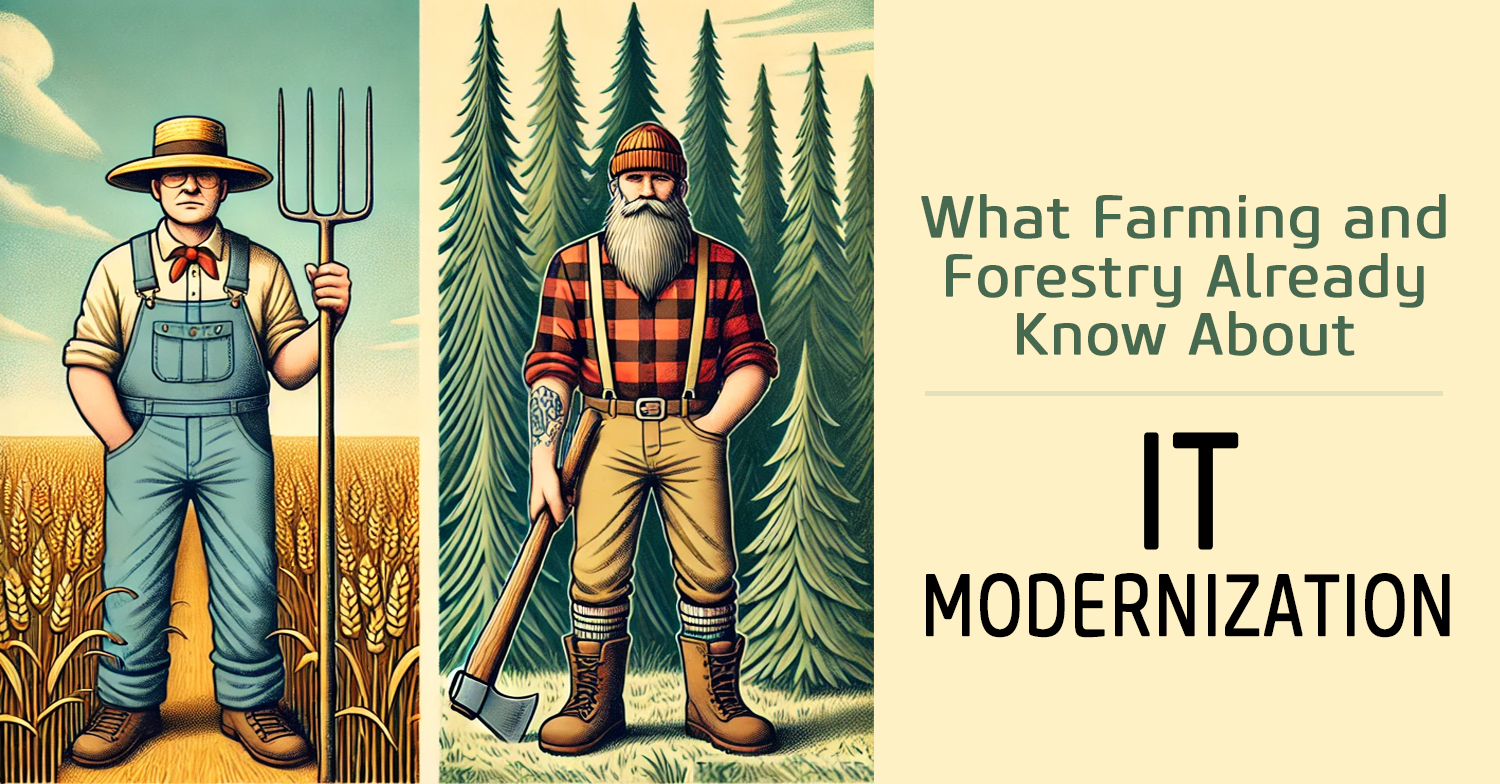Modernization can feel like an overwhelming challenge, especially when facing critical legacy systems deeply embedded in the organization’s operations.
Approaching modernization as an all-at-once overhaul may be risky, both financially and operationally, but adopting a phased strategy can offer a more balanced path. This is where the concept of a “controlled burn” comes in—a deliberate, gradual approach to modernization that reduces risk while preserving business continuity.
This article will explore why gradual modernization can be the safest way to bring your tech stack up to date, while strategically managing risk, cost, and disruption.
What Is a Controlled Burn in Modernization?
Borrowed from forestry and farming, a “controlled burn” is a carefully managed fire that removes undergrowth, deadwood, and crop residues, making the environment healthier in the long term while minimizing the risk of uncontrolled disasters. In farming, controlled burns are often used to clear crop stubble, enrich soil, and control pests. Similarly, in IT modernization, a phased approach acts like a controlled burn—it allows you to gradually eliminate outdated technology in a way that minimizes disruption and preserves the stability of core operations.
Phased modernization means upgrading or replacing legacy systems over time rather than attempting an all-encompassing overhaul. This approach offers many advantages:
- Reduced Risk: Smaller, incremental changes introduce fewer points of potential failure.
- Predictable Costs: Phased upgrades can be more budget-friendly and easier to forecast over time.
- Minimized Disruption: By focusing on one system or component at a time, businesses can continue operations smoothly.
- Opportunities for Adjustment: A phased approach allows companies to reassess and adjust based on new technological advancements or organizational needs.

Controlled Burns in Farming: A Paralleling Strategy
In farming, controlled burns are used to prepare fields for planting by clearing old vegetation, controlling weeds, and promoting healthier soil. For example:
- Pest and Weed Control: Controlled burns can destroy weeds and their seeds, reducing competition for crops while eliminating pests that overwinter in crop residues.
- Soil Enrichment: Burning crop stubble releases nutrients like nitrogen and phosphorus into the soil, creating a fertile ground for new planting.
- Improved Water Absorption: Removing dense, dead vegetation allows rain to penetrate the soil more effectively, promoting healthier crop growth.
Just as these controlled burns create the conditions for better farming outcomes, gradual modernization clears the path for healthier IT systems and business operations.
Why Go Gradual? Benefits of a Phased Modernization Approach
In a business landscape where even a minor outage can disrupt productivity, modernization requires careful planning. Gradual modernization offers several distinct benefits.
Lower Immediate Impact on Operations
Legacy systems often run mission-critical functions, so sudden changes or large-scale transformations can be highly disruptive. A phased approach limits the impact on day-to-day operations, allowing the business to continue as usual while individual components are upgraded.
- Example (IT): Upgrading customer relationship management (CRM) software to cloud-based platforms can be managed separately from other systems, with minimal impact on users in other departments.
- Example (Farming): Controlled burns clear invasive weeds gradually, so planting and harvesting cycles remain uninterrupted while improving overall yields.
- Example (Forestry): Selective logging focuses on removing mature or diseased trees in phases, preserving the overall forest ecosystem and minimizing disruption to habitats while optimizing timber yield.
Controlled Budget and Resources
All-at-once modernization can strain budgets and stretch resources thin. By taking a gradual approach, companies can allocate funds more predictably, avoiding large capital outlays and reducing the need for emergency fixes.
- Example (IT): A phased rollout of cloud infrastructure spreads costs across multiple budget cycles.
- Example (Farming): Scheduling controlled burns between growing seasons ensures that resources for crop rotation and soil enhancement are optimized.
- Example (Forestry): Phased reforestation efforts spread the costs of planting seedlings over several years, ensuring consistent funding for soil preparation, seedling care, and maintenance without overwhelming budgets.

Flexibility to Adjust Strategy Over Time
Technology evolves rapidly, and a phased approach allows companies to adapt to changes in the tech landscape. Similarly, controlled burns in farming allow adjustments based on weather conditions, soil analysis, or pest trends.
- Example (IT): A hybrid cloud adoption might expand incrementally as security and compliance standards evolve
- Example (Farming): Farmers might increase burn frequency or alter timing based on weed and pest prevalence during specific years.
- Example (Forestry): Selective logging focuses on removing mature or diseased trees in phases, preserving the overall forest ecosystem and minimizing disruption to habitats while optimizing timber yield.
Steps for a Successful Controlled Burn in Modernization
A gradual modernization approach requires a well-planned roadmap that defines each phase, manages expectations, and prepares the business for incremental change.
1. PRIORITIZE YOUR SYSTEMS
Not all systems require immediate modernization. Start with those that are the most critical.
Tip: Conduct impact assessments to prioritize systems.
2. DEVELOP A PHASED MODERNIZATION ROADMAP
Outline a step-by-step roadmap that includes timelines and milestones.
Tip: Incorporate flexibility for unforeseen factors.
3. CONDUCT CONTROLLED TESTING & ROLLOUTS
Each phase should be tested before implementation.
Tip: Involve end-users early to gather feedback and refine solutions.
4. ESTABLISH FEEDBACK LOOPS
Set up mechanisms to capture performance data and refine the process for future phases.
Tip: Use insights to adjust and enhance subsequent phases.
Conclusion: Modernization as a Strategic Burn
The art of a controlled burn in modernization lies in balancing innovation with risk management. Whether in forestry, farming or IT, this strategy ensures that incremental changes lead to long-term growth and sustainability.
By upgrading in stages, businesses can minimize immediate risks, adapt to emerging needs, and create a strong foundation for future success.
LEARN MORE ABOUT PROJECT MANAGEMENT WITH ONLINE!
By carefully listening to our client’s needs and then applying industry best practices, our project managers create a project environment that delivers success.
About the Author

With almost thirty years of experience in the IT industry, Duane Colley is a Sr. Solution Architect specializing in the definition and delivery of adaptable, quality systems. Highly analytical, Duane leverages his experience to ensure that technology solutions effectively meet client’s business needs. Duane has experience in the Health, Telecommunications, Agribusiness, Government, Energy and Manufacturing industries.




Submit a Comment